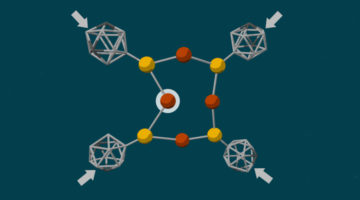Researchers used in situ high-pressure diffraction to resolve a debate about whether a metal’s strength increases or decreases when its grain size decreases below a critical point. The results indicate that ultrastrong metals for future applications can indeed be achieved through grain-size refinement and grain-boundary engineering. Read more »
Can Minerals in the Earth’s Lower Mantle Store Water?
Earth is considered a watery planet, simply by virtue of the fact that 71% of its surface is covered by oceans. But researchers have discovered that, in the massive volume of material in Earth’s interior, minerals can serve as an important water reservoir, providing a new perspective on our planet’s water budget. Read more »
Argon: Not So Noble in Earth’s Core
Researchers demonstrated the synthesis of a thermodynamically stable compound of argon and nickel at temperatures and pressures representative of the Earth’s core. The ability of argon, a noble gas, to react with other elements under these conditions may help solve outstanding geological questions, including the “missing argon paradox.” Read more »![]()
A High-Pressure Compound of Argon and Nickel: Noble Gas in the Earth’s Core?
Researchers demonstrated the synthesis of a thermodynamically stable compound of Ar and Ni at thermodynamic conditions representative of the Earth’s core. The results suggest that the abundance of Ar in the Earth’s core is beyond a simple solubility of Ar in molten Ni–Fe but in chemical reactions in nature. Read more »
Pressure-driven band gap engineering in ion-conducting semiconductor silver orthophosphate
This work explores a novel method to tune the electronic band structures of active semiconductor photocatalysts to gain insight into structure–property relationships. Taking silver orthophosphate (Ag3PO4) as an example, a static pressure technique was applied to modulate the band gap and indirect–direct band character via altering its crystal structure and lattice parameters. Read more »
Palladium and Zirconium Convert Greenhouse Gases into Fuel
Greenhouse gases cause the rising global temperatures associated with climate change. At the ALS, researchers have determined that palladium/zirconium catalysts can reduce greenhouse gases like methane and carbon dioxide by converting them into useful fuel. Read more »![]()
Molecular Anvils Trigger Chemical Reactions
“Molecular anvils” (diamondoids) were used to trigger chemical reactions using pressure, yielding products that differ from those produced in conventionally driven reactions with the same reactants. The discovery opens up new possibilities for the high-specificity synthesis of valuable but challenging molecules in an environmentally friendly process. Read more »![]()
![]()
From Moon Rocks to Space Dust: Berkeley Lab’s Extraterrestrial Research
Berkeley Lab has a well-storied expertise in exploring samples of extraterrestrial origin. This research—which has helped us to understand the makeup and origins of objects within and beyond our solar system—stems from long-standing core capabilities in structural and chemical analyses and measurement at the microscale and nanoscale. Read more »
New Evidence for a Water-Rich History on Mars
Mars may have been a wetter place than previously thought, according to experiments on lab-synthesized mineral samples serving as proxies for Martian meteorites. Shock experiments followed by x-ray diffraction studies showed how changes in the minerals could indicate a more water-rich history for the Red Planet. Read more »![]()
![]()
New Insights into Nanoscale Deformation
A group of scientists used Laue x-ray microdiffraction at the ALS to probe plastic deformation mechanisms at the nanoscale. Their findings may overturn conventional theory and reshape our understanding of the mechanical behavior of a host of nanocrystalline metals. Read more »









